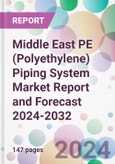According to the report, the Middle East PE (polyethylene) piping system market is projected to grow at a CAGR of 7.20% between 2024 and 2032 to reach a value of about USD 3.85 Billion by 2032. Aided by the burgeoning construction sector, infrastructural development, and the growing need for water management systems in the region, the market is expected to grow significantly by 2032.
Polyethylene, a versatile and durable polymer, is extensively employed in the manufacturing of piping systems. These PE piping systems are gaining traction in the Middle East due to their corrosion resistance, flexibility, and long service life. Primarily used in water supply, sewage systems, gas distribution, and desalination plants, PE pipes are rapidly replacing conventional materials like steel and concrete in various applications.
A significant driver propelling the Middle East PE (polyethylene) piping system market growth is the region's pressing need for efficient water management. Given the arid climate and water scarcity issues in many Middle Eastern countries, there is a growing emphasis on efficient water distribution and waste management systems. PE pipes, with their leak-proof nature and durability, present an optimal solution to these challenges.
As per the Middle East PE (polyethylene) piping system market analysis, the vast infrastructural and construction projects, both ongoing and planned, across the region provide a significant boost to the demand for PE piping systems. Countries like Saudi Arabia, the UAE, and Qatar are experiencing urbanisation at a rapid rate, necessitating the development of robust and efficient utility networks, wherein PE pipes play a crucial role.
The gas distribution sector in the Middle East is another lucrative area for the PE piping system market. With the region being home to some of the world's largest oil and gas reserves, there's an inherent need for reliable and resilient piping systems to ensure safe transportation. PE pipes, owing to their resistance to chemical reactions and their ability to maintain structural integrity under varying temperature ranges, are ideally suited for this purpose.
The sustainable aspect of PE pipes further influences the Middle East PE (polyethylene) piping system market outlook. With increasing awareness about environmental conservation, there's a noticeable shift towards products and systems that are eco-friendly. PE pipes, being recyclable and having a reduced carbon footprint compared to many alternatives, align with this sustainability trend.
Polyethylene, a versatile and durable polymer, is extensively employed in the manufacturing of piping systems. These PE piping systems are gaining traction in the Middle East due to their corrosion resistance, flexibility, and long service life. Primarily used in water supply, sewage systems, gas distribution, and desalination plants, PE pipes are rapidly replacing conventional materials like steel and concrete in various applications.
A significant driver propelling the Middle East PE (polyethylene) piping system market growth is the region's pressing need for efficient water management. Given the arid climate and water scarcity issues in many Middle Eastern countries, there is a growing emphasis on efficient water distribution and waste management systems. PE pipes, with their leak-proof nature and durability, present an optimal solution to these challenges.
As per the Middle East PE (polyethylene) piping system market analysis, the vast infrastructural and construction projects, both ongoing and planned, across the region provide a significant boost to the demand for PE piping systems. Countries like Saudi Arabia, the UAE, and Qatar are experiencing urbanisation at a rapid rate, necessitating the development of robust and efficient utility networks, wherein PE pipes play a crucial role.
The gas distribution sector in the Middle East is another lucrative area for the PE piping system market. With the region being home to some of the world's largest oil and gas reserves, there's an inherent need for reliable and resilient piping systems to ensure safe transportation. PE pipes, owing to their resistance to chemical reactions and their ability to maintain structural integrity under varying temperature ranges, are ideally suited for this purpose.
The sustainable aspect of PE pipes further influences the Middle East PE (polyethylene) piping system market outlook. With increasing awareness about environmental conservation, there's a noticeable shift towards products and systems that are eco-friendly. PE pipes, being recyclable and having a reduced carbon footprint compared to many alternatives, align with this sustainability trend.
Market Segmentation
The market can be divided based on type, application, and country.Market Breakup by Type
- HDPE
- MDPE
- LDPE
- LLDPE
- Others
Market Breakup by Application
- Water Supply
- Irrigation
- Sewerage and Drainage
- Gas Supply
- Mining and Slurry Lines
- Others
Market Breakup by Country
- Saudi Arabia
- United Arab Emirates
- Iran
- Israel
- Turkey
- Others
Competitive Landscape
The report looks into the market shares, plant turnarounds, capacities, investments, and mergers and acquisitions, among other major developments, of the leading companies operating in the Middle East PE (polyethylene) piping system market. Some of the major players explored in the report are as follows:- Saudi Plastic Products Company Ltd.
- Alwasail Industrial Company
- Jubail Pipes
- IKK Group
- Others
Table of Contents
1 Preface2 Report Coverage - Key Segmentation and Scope4 Key Assumptions7 Opportunities and Challenges in the Market11 Value Chain Analysis13 Key Trends and Developments in the Market
3 Report Description
5 Executive Summary
6 Market Snapshot
8 Middle East PE (Polyethylene) Piping System Market Analysis
9 Regional Analysis
10 Market Dynamics
12 Competitive Landscape
List of Key Figures and Tables
Companies Mentioned
- Saudi Plastic Products Company Ltd.
- Alwasail Industrial Company
- Jubail Pipes
- IKK Group
Methodology

LOADING...








